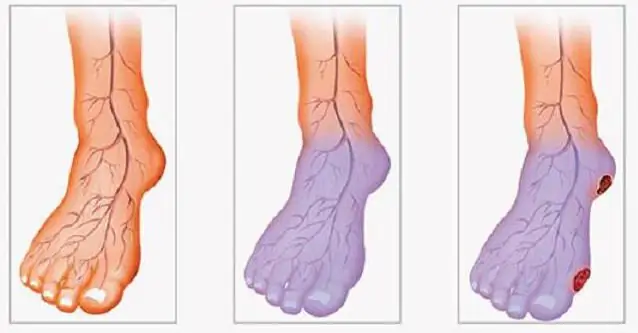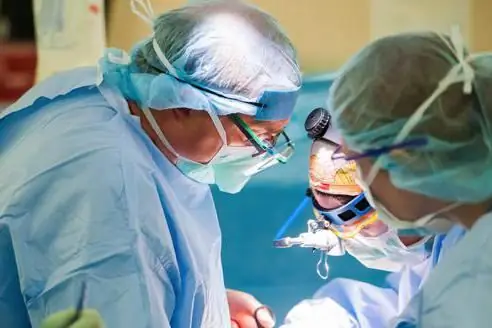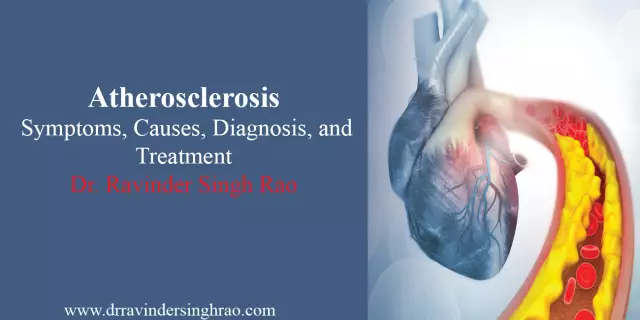- Author Curtis Blomfield [email protected].
- Public 2023-12-16 20:44.
- Last modified 2025-01-23 17:01.
Atherosclerosis is a common disease that has several varieties. Among the variety of pathological processes, the stenosing form deserves special attention. It most often occurs in men over 50 years of age. With age, atherosclerotic changes in the vessels occur in the body of many people. They are not only characterized by the appearance of unpleasant symptoms, but also pose a serious threat to life. In this article, we will consider the main localizations and symptoms of stenosing atherosclerosis, as well as the methods of treating the disease proposed by doctors.
Description of the disease and mechanism of development
Stenosing atherosclerosis is a pathological process that spreads to the main arteries of the body. The mechanism of its occurrence is quite simple. Under the influence of certain factors in the walls of blood vessels beginfree fats (cholesterol) are deposited and plaques form. The disease goes through several stages of development, the final stage is the narrowing of the artery to a minimum (stenosis). As a result, tissues and organs dependent on the site of impaired blood supply experience a lack of oxygen and nutrients.

The problem of the growth of cholesterol plaques and the connective tissue between them affects various main arteries. Taking into account the place of development of the pathological process, there are several varieties of the disease. The most vulnerable are the peripheral arteries of the lower extremities, the brain and the coronary aorta of the heart. Lack of timely treatment usually leads to irreversible consequences: myocardial infarction, gangrene of the legs, stroke, thromboembolism with damage to internal organs.
Main reasons
The development of atherosclerotic lesions of the main arteries is due to the action of three factors:
- Violation of fat metabolism. When the body's system for the synthesis and transportation of cholesterol fails, excesses of this substance begin to be deposited on the walls of blood vessels. Somatic diseases, unbalanced nutrition, obesity can act as a trigger mechanism.
- Hereditary predisposition. If close relatives have been diagnosed with stenosing atherosclerosis, the likelihood of this disease increases several times.
- Decrease in the elasticity of the vascular walls. Cholesterol plaques cannot form onsmooth and he althy surface. The following disorders contribute to damage to the vascular wall: diabetes mellitus, sedentary lifestyle, smoking.
If one or more of the factors listed above are present, it is necessary to pay special attention to one's own he alth, to undergo preventive examinations more often.
Manifestations of cerebral artery stenosis
The brachiocephalic arteries are large vessels that branch from the aortic arch towards the brain. Their multiple weaves form the circle of Willis. It provides a full blood supply to the brain.
When an obstacle in the form of an atherosclerotic plaque forms in one of the sections of the circle of Willis, they speak of the development of stenosis. This disease affects the entire blood supply system of the brain. Lack of timely treatment can lead to hypoxia or stroke. Signs of the pathological process depend on the number of atherosclerotic plaques in the arterial bed.
At the very beginning, the disease is asymptomatic. If the lumen of the vessel is blocked by plaque by 50% or more, the patient may note the appearance of uncharacteristic disorders. Among them are:
- periodic dizziness against the background of a decrease in blood pressure;
- emotional lability with a predominance of depressive mood;
- absent-mindedness;
- hearing-visual problems (tinnitus, hearing loss, flies before the eyes);
- chronic fatigue syndrome;
- numbness of fingers;
- thermoregulation disorder.
The listed symptoms at first practically do not affect the quality of life. Many patients simply ignore them. Progressive stenosing atherosclerosis of the brachiocephalic arteries forces you to seek medical help.

Manifestations of stenosis of the vessels of the heart
Oxygen and nutrients are delivered to the heart through the coronary arteries. The defeat of these vessels by atherosclerosis poses a serious threat to the main muscle of the body, affecting its rhythm and completeness of contractions. With this disease, patients usually complain of pain in the retrosternal space. They first appear after exercise or stress. Over time, discomfort does not leave a person even at rest. The duration of the pain attack is about 30 minutes.
Myocardial infarction is considered an acute manifestation of the pathological process. The disease is accompanied by severe pain in the region of the heart, which cannot be stopped with a Nitroglycerin tablet. Blood pressure drops, resulting in severe dizziness, weakness. Atherosclerosis stenosing, affecting the coronary arteries, can lead to serious complications. These include cardiac aneurysm, cardiogenic shock, and rupture of the muscle itself. Especially often, doctors diagnose sudden death syndrome.
Manifestations of stenosis of the arteries of the lower extremities
Through the femoral artery, blood flows to the most extreme points of the body, located on the feet. Stenosing atherosclerosislower extremities ranks third in terms of frequency of occurrence. The clinical manifestations of this form of the disease are diverse. Therefore, it is advisable to consider the development of the pathological process in stages:
- At the initial stage, the patient is disturbed by a feeling of chilliness, burning or tingling in the feet. The skin on the legs becomes noticeably paler.
- The second stage is characterized by the appearance of intermittent claudication. One limb, when walking or playing sports, begins to get tired before the other. Unpleasant sensations gradually develop in the area of the calf muscles, persistent cyanosis appears.
- At the next stage, the intensity of intermittent claudication increases markedly. It becomes difficult for the patient to walk the usual path without stopping. Often patients complain of pain in the toes that does not go away at rest. The skin on the foot acquires a marbled hue, may crack and thin.
- At the fourth stage, lameness becomes so pronounced that a person is forced to make stops every 50 steps. Perhaps the appearance of trophic ulcers, swelling. Severe pain in the legs interferes with a night's rest.
We cannot wait for the irreversible consequences of the disease in the form of gangrene. If you experience symptoms of circulatory disorders in the legs (weakness, intermittent claudication), you should immediately consult a doctor. If the specialist confirms stenosing atherosclerosis of the arteries of the lower extremities, treatment will be prescribed immediately.

Diagnostic Methods
In order to timely identify the disease and begin its therapy, doctors recommend that all people over 40 years old undergo a preventive examination once a year. It is enough to take a blood test for the following indicators:
- cholesterol, lipoproteins, triglycerides;
- fibrinogen;
- glucose;
- clotting.
These parameters may indirectly indicate a violation of protein-lipid metabolism, which provokes the development of pathology.
Stenosing atherosclerosis of the arteries of the brain, heart or lower extremities is easy to diagnose. To do this, the patient is prescribed a comprehensive examination, which includes the following procedures:
- intravenous/arterial angiography with contrast;
- rheovasography;
- doppler study;
- triplex scanning.
Based on the results of the examination, the doctor can confirm the preliminary diagnosis. After that, the patient is prescribed treatment.

Principles of Therapy
Treatment of stenosing atherosclerosis largely depends on at what stage of the development of the disease the patient went to the doctor. At the initial stage, in addition to drug therapy, you should try to change your lifestyle. It is important to give up bad habits, try to relax more. Otherwise, taking medication will only slow down the progression of the disease, but will not stop it completely.
Without fail, the doctor prescribes to the patient a diet (table number 10), richvegetable food. It is usually recommended for patients with hypertension or heart failure. If you stick to such a diet, you can not only reduce the amount of cholesterol consumed, but also remove its excess from the body. In this case, you can not go on a diet for weight loss. Nutrition should be balanced and complete. Otherwise, therapy will not bring the desired result.
Patients diagnosed with "stenosing atherosclerosis of the lower extremities" treatment should be supplemented with sports. Preference should be given to Nordic walking or swimming. At the first signs of fatigue in the legs, you should immediately rest, without overloading the body.

Medication use
Treatment of atherosclerosis is impossible to imagine without the use of medicines. Typically, patients with this diagnosis are prescribed the following groups of drugs:
- Disaggregants. Prevent the formation of blood clots in the bloodstream.
- Anspasmodics. Improve blood circulation throughout the body.
- Medications to normalize the rheological properties of blood. First, a drip of the drug is prescribed, then it is replaced with a tablet form.
- Anticoagulants.
All medicines are selected for each patient individually. Be sure the doctor must take into account the stage of the disease and its form.
Surgery
Stenosing atherosclerosis in advanced stage requires surgery. Surgicalintervention allows you to restore the normal patency of blood vessels, remove cholesterol plaques. For this purpose, shunting, stenting or angioplasty is performed. The listed manipulations are carried out both endoscopically and openly using general anesthesia.

Consequences of the disease
The consequences of this disease can be very serious and life-threatening. For example, stenosing atherosclerosis of the arteries of the brain often provokes the development of a stroke. Of course, this complication does not appear for everyone. It all depends on the characteristics of the organism, the predisposition to the onset of the disease. Studies show that approximately 70% of the population over 60 complains of various manifestations of atherosclerosis. This pathology is the main cause of brain failure syndrome.
Stenosing atherosclerosis of the vessels of the lower extremities also does not always have a favorable prognosis. If the artery is completely blocked, the likelihood of developing ischemic gangrene increases. Especially often, pathology occurs in people with diabetes, since this disease accelerates the process of stenosis.
Prevention measures
Starting prevention of stenosing atherosclerosis is necessary from early childhood. All people who follow an unhe althy lifestyle are at risk of developing the disease.
Prevention includes:
- hygienic mode;
- moderate exercise;
- compliance with the working regime andrest.
Don't forget about proper nutrition. The diet should consist mainly of lean meat and seafood, as well as plant foods.
A he althy lifestyle means giving up bad habits. However, it is better not to start smoking and drinking alcohol at all.

The above recommendations must be followed both during and before therapy. Such advice can help you avoid complications of the disease. When the first symptoms appear, indicating stenosing atherosclerosis, you should consult a doctor and check the vessels. If necessary, the doctor will prescribe the appropriate treatment.






